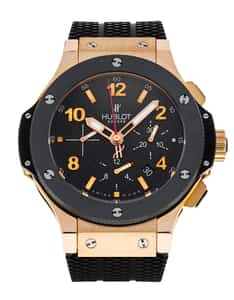Pre-Owned
Hublot Watches
Established 1980
Hublot burst onto the watchmaking scene in 1980, revolutionising the industry with its instantly popular porthole-shaped design. The brand is dedicated to the 'Art of Fusion', combining new and groundbreaking composite materials with the traditional Swiss methods with which the watches are built.
View AllNew Arrivals
- New Price
- Limited Edition
- HublotBig Bang401.NQ.0123.VR
- Box Papers
- Year 2016
- €11,540
- New Price
- HublotClassic Fusion511.NX.2611.LR
- Box Papers
- Year 2019
- €6,090
- New Price
- Limited Edition
- HublotUnico411.EX.5120.NR
- Box Papers
- Year 2020
- €18,315
- New Price
- Limited Edition
- HublotBig Bang451.EX.5120.EX
- Box Papers
- Year 2023
- €16,125
Hublot History
Hublot is a relatively new brand, but its history is already as prestigious and explosive as its watches. The company began life in 1980 as the brainchild of Carlo Carocco, who had recently left the major Italian fashion house Binda in order to pursue his own career in watches. After several years’ planning, Carocco had his first watch, which he dubbed Hublot—and soon he was calling his fledgling brand the same thing. The word means ‘porthole’ in French, which is what his watch resembled: a strong circular shape punctuated by bolts around a heavy-set bezel. It was an instantly popular formula that the brand today has taken and run with. But that first Hublot watch was more remarkable for its strap than its case shape or minimalist dial. The strap was made of natural rubber, a first for Swiss watches. The powerful new combination of gold watch and rubber strap lead to the brand’s first collection and another overarching theme in its history: fusion. The ‘80s saw the gradual development of the ideas that had been born in the Fusion and Classic Fusion series. Beautiful diving watches and chronographs were made to fit the theme, and later there were dress watches called Elegant Chronographs that dropped the bolts and smoothed some of the Fusion's hard lines. Eventually, Carocco determined that he wanted to focus on other projects, and found a new CEO for the company in the shape of Jean-Claude Biver. Biver was already well-known by this point, having helmed the likes of Omega and Blancpain, and having played a major role in establishing the Swatch Group and rescuing the industry from the quartz crisis. He now took on the role of rejuvenating Hublot watches, something he achieved in a most spectacular fashion. Biver took the reigns in 2004, and at Baselworld 2005 he revealed his masterpiece: the Big Bang. Drawing on and expanding the porthole and fusion ideas of previous watches, the design was instantly hailed as outstanding, and the Big Bang is now firmly established as one of the most iconic sports watches of the 21st century. Boisterous and imposing, the watch is simultaneously fun-loving and yet rooted in a classic aesthetic, and easily adaptable into myriad versions and special editions. After winning that year’s Grand Prix d'Horlogerie de Geneva, the Big Bang has gone on to claim dozens of other awards and recognitions, as well as record-beating sales. Riding this success, Hublot began expanding. It opened its first boutiques around the world (there are now more than 50, including one in Ulan Bator, the capital of Mongolia), and even launched a TV channel—a surprising move for a watch company. New kinds of Big Bang kept appearing, including amazing gem-set variants and diving watches, and these were later joined by the even bigger and bolder King Power and the more experimental MP series, which included a watch with an astounding 50-day power reserve. The first ladies’ Big Bang appeared in 2008, shortly before Hublot was bought by luxury conglomerate LVMH. It was also around this time that the brand began its famous association with professional football, sponsoring first Euro 2008 and then the Fifa World Cup and Manchester United, each with its own special edition watch.
























